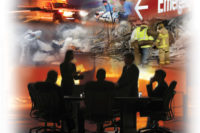This article is based on the non-fiction book, “Trapped Under the Sea,” written by Neil Swidey and published in 2014 by Crown Publishing Group. Assisting with this article was Tania Clarke.
Some jobs obviously carry a higher risk than others. Often when we start a job we are aware and cautious. As time goes on, many of us become comfortable, with a false sense of security.
This behavior is described as “normalization” -- also known as habituation. Habituation is defined as the diminishing of a physiological or emotional response to a frequently repeated stimulus.
It is why workplace accidents tend to happen later in a project, as noted by Neil Swidey, author of “Trapped Under the Sea.”
Neil has spent years researching workplace health and safety data. Writing in the Harvard Business Review, he reports that whether it’s a small home-improvement project or a large public infrastructure mega project, trouble typically arises late in the project timeline:
“The more people do something without suffering a bad outcome, the harder it becomes for them to remain aware of the risks associated with that behavior. The most obvious example of this in everyday life is texting while driving. Most of us have been guilty of this risky behavior, even if we don’t want to admit it. And if we’ve never suffered an accident as a result of all of furtive thumbing from behind the wheel, we might have even fooled ourselves into thinking we’re just better at it than most people. We’re not. That’s simply the seductive yet slippery power of normalization at work.”
Tips to avoid normalization
• Identify hazards, circumstances and conditions to look out for at the start of the project. Have a weekly checklist meeting to mitigate risks by keep tracking of all identified risks.
• Consider a behavior observation program.
• Be realistic about project milestones and completion dates set in place.
• Make everyone a safety hero and give them the checklists and tools to self-assess at all stages.
• Set up a reward program for employees who identify potential risks.
High confidence, low tolerance
Injuries and deaths often occur late in the job, when confidence runs high (if there have been no major accidents) and tolerance for delays dips low. This is when normalization kicks in, which often allows people to accept looser standards in the name of greater speed (meet or beat the deadline). The more people do something without suffering a bad outcome, the harder it becomes for them to remain awareness of the risks associated with at-risk behavior.
Lesson from under the sea
Before Neil spent five years researching his book “Trapped Under the Sea,” the true story of a team of commercial divers sent to finish the multibillion-dollar cleanup of Boston Harbor, he intuitively assumed that the most dangerous time on a job was Day One. After all, that’s when workers are usually getting oriented to a new setting, new colleagues, and new equipment, and when the learning curve is steepest. But after marinating in workplace safety data, Neil came to understand that the opposite is true.
In the 1980s, Boston had the dirtiest harbor in America. Today, Boston has what is widely considered the cleanest urban harbor in America, one of the most dramatic environmental transformations in recent American history. Yet it came at a deadly cost. The massive cleanup effort, which took more than a decade and cost $4 billion, claimed the lives of five workers. Tellingly, none of those fatalities happened early in the job.
Two deaths involved a small team of divers dispatched to the far end of the world’s longest tunnel of its kind, a ten-mile long dead-end tube carved into the bedrock hundreds of feet of below the ocean floor. This Deer Island Outfall Tunnel was the largely overlooked centerpiece of the harbor cleanup. Up to one-billion gallons of wastewater now flows through the tunnel and out to sea every day, with gravity serving as the only power source.
For the decade it took to build this engineering marvel, electrical power, rail transportation, and ample ventilation all flowed through the full length of the tunnel. These were the utilities that kept tunnel workers alive.
Clouded thinking
At the conclusion of the tunnel construction, the various best-and-brightest minds overseeing the project were engaged in bitter battles over cost overruns. A dangerous game of corporate chicken played out. Managers decided to remove the electrical power, rail transportation, and ventilation system. At the far end of the tunnel, 55 large safety plugs still needed to be removed. To do this, managers sent a team of commercial divers to travel – first by vehicle, then by foot – to the end of the pitch-black, oxygen-starved tunnel. At the tunnel’s end, the divers had to shimmying into the series of slimy 55 connector pipes -- so narrow that they were scarcely wider than each diver’s shoulders. In each connector pipe, they would need to remove a heavy safety plug that had helped keep workers safe during the decade it took to build the tunnel, by keeping the Atlantic Ocean out of it.
Five divers were sent in. Only three made it out alive. And even those three survivors came within 30 seconds of losing their lives.
The tunnel was 24 feet wide at the start, but just five feet in diameter at the end. Then the divers had to crawl into a series of 30-inch-wide pipes to remove the plugs. Because the distance was too far to rely on the conventional supply of bottled air, the diving company's project manager came up with an experimental system: the divers would need to mix their breathing air in the tunnel, using the vapors from tanks of liquid oxygen and liquid nitrogen. They relied on souped-up Hummer Humvees to get them part way into the tunnel. But when it became too narrow, they had to trudge along on foot, lugging their equipment with them, in the dark.
The deaths of two of the divers resulted from the experimental -- and defective -- breathing apparatus. How could the project’s managers, who had demonstrated remarkable skill and prudence for a decade on this job, have made such a colossally bad decision involving the breathing system at the very end of the project, gambling with other people’s lives?
They had fallen victim to normalization. In this case, people accepted looser standards in the name of greater speed. As noted, the more people do something without suffering a bad outcome, the harder it becomes for them to remain aware of the risks associated with that behavior.
Broad lessons
This underwater tragedy has lessons for any task “involving some level of hazard, from cleaning gutters to chopping vegetables. If it was worth climbing down from the ladder to move it a few feet at the beginning of the job, it should be worth taking that same sensible precaution near the end,” Swidey writes.
“Whenever a worker dies, there is a natural inclination to hunt for a huge, single failure that can be blamed. In reality, a worker’s death is usually caused by a series of small, bad decisions made by many individuals, none of which, on its own, would have been enough to produce a fatality. Disaster strikes only when all the holes in the Swiss cheese line up, “ he writes.
Those holes tend to line up at the end of a project, due to time pressures, frustrations, impatience, stubbornness, becoming habituated and immune to risks -- and even more so if there are cost-overruns and long delays in reaching the project’s completion.
One example of the time pressure involved: The divers sent into the tunnel had about two weeks to train and get to know one another. For high-risk space missions NASA typically gives its teams at least a year to train, Swidey said in an interview on www.signature-reads.com.
“The particulars of the accident at the center of the book are so unusual that they will likely never be repeated again,” said Swidey. “But the forces that set in motion the problems are universal to ambitious undertakings of every kind. I think that’s what makes the lessons embedded in this book so valuable.
“This project attracted some of the best and brightest minds in the country. And no one consciously set out to put these divers’ lives on the line. Yet that’s exactly what they had done. The massive infrastructure projects that make modern life possible -- our bridges, tunnels and skyscrapers -- all require some amount of risk for the workers charged with converting design into reality. We owe it to the workers we put into harm’s way to make sure we've done whatever is possible to minimize that risk.”
Neil Swidey is the author of “Trapped Under the Sea: One Engineering Marvel, Five Men, and a Disaster Ten Miles Into the Darkness,” which was named one of the best books of 2014 by Amazon and Booklist. It is now out in paperback. A staff writer for The Boston Globe Magazine, Swidey is also the author of “The Assist “and co-author of the Ted Kennedy biography, “Last Lion.”
Parts of this article were posted as a blog by Tania Clarke on https://safetyculture.com. SafetyCulture is a technology company that develops innovative, low-cost, mobile-first applications that empower users to have safe and efficient workplaces.



